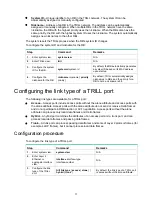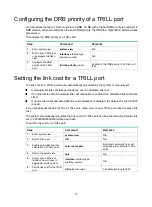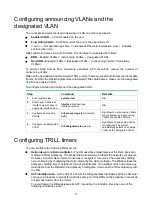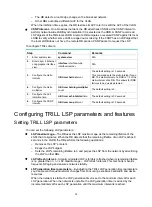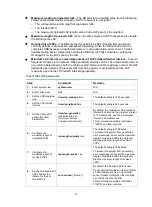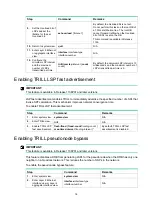
1
Configuring TRILL
TRansparent Interconnection of Lots of Links (TRILL) uses IS-IS to provide transparent Layer 2
forwarding.
TRILL requires a license to run on the device. For information about feature licensing, see
Fundamentals Configuration Guide
.
Overview
TRILL combines the simplicity and flexibility of Layer 2 switching with the stability, scalability, and
rapid convergence capability of Layer 3 routing. All these advantages make TRILL very suitable for
large Layer 2 networks in data centers.
Basic concepts
•
RBridge
—Routing bridge (RB) that runs TRILL. RBs are classified into ingress RBs, transit
RBs, and egress RBs, depending on their positions in the TRILL network. A frame enters the
TRILL network through an ingress RB, travels along transit RBs, and leaves the TRILL network
through an egress RB, as shown in
.
•
TRILL
network
—A Layer 2 network that contains RBs, as shown in
•
System
ID
—Unique identifier of an RB in the TRILL network. The system ID is 6 bytes in
length.
•
Nickname
—Address of an RB in the TRILL network. The nickname is 2 bytes in length.
•
Link State Database
—The LSDB contains all link state information in the TRILL network.
•
Link State Protocol Data Unit
—An LSP describes local link state information and is
advertised between neighbor devices.
•
Designated Routing Bridge (DRB)
—Similar to the designated IS (DIS) in IS-IS, a DRB exists
in a broadcast network. It helps simplify network topology, and assigns AVFs and appointed
ports for the VLANs on each RB in the broadcast network.
•
Appointed VLAN-x Forwarder (AVF)
and
appointed port
—To avoid loops, TRILL requires all
traffic of a VLAN on a broadcast network to enter and leave the TRILL network through the
same port of an RB. The RB is the VLAN's AVF, and the port is the VLAN's appointed port.
For more information about LSDB, LSPDU, and DIS, see
Layer 3—IP Routing Configuration Guide
.
TRILL frame formats
TRILL frames include protocol frames and data frames.
TRILL protocol frames include TRILL Hello, LSP, CSNP, PSNP, MTU-probe, and MTU-ack. These
protocol frames use 802.1Q encapsulation and have a fixed destination multicast address
0180-C200-0041.
TRILL data frames have a specific format, as shown in
. A TRILL header and an outer
Ethernet header are added to the original Ethernet frame.

















